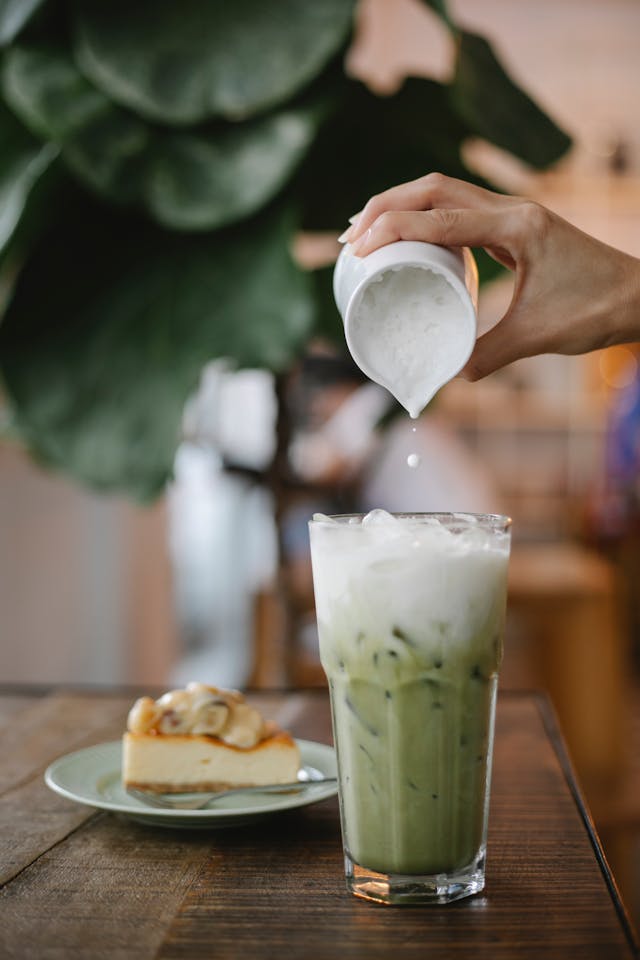Introduction to Matcha Coffee
In the beverage arena, new developments pop up every 12 months, but one that’s captured the hearts of espresso fans and fitness fans alike is matcha coffee. This delightful drink combines espresso’s bold richness with matcha’s earthy sweetness, creating a beverage that offers the best of both worlds. But what exactly is matcha coffee, and why is it gaining so much popularity?
The Origins of Matcha and Coffee
Discovering the origins of matcha and coffee is critical to understanding the magic of matcha coffee.
Matcha is a finely ground inexperienced tea powder that has been consumed in Japan for hundreds of years, historically as part of tea ceremonies. Made from color-grown tea leaves, matcha is known for its vibrant green coloration and smooth, grassy flavor.
Coffee, however, has a rich history dating back to the fifteenth century in the Arabian Peninsula, where it was first brewed as a beverage. Coffee’s sturdy and barely sour taste and its stimulating effects have made it a staple drink worldwide.
Why Combine Matcha and Coffee?
At first glance, matcha and espresso seem like an abnormal combination. After all, they’re both energizing drinks, but they supply their strength boosts in unique ways. So why blend them?
- Complementary Health Benefits: Matcha is full of antioxidants and presents calming, focused electricity due to its L-theanine content. Coffee is known for its caffeine enhancement. Together, they offer sustained power without the jitters.
- Unique Flavor Profile: Coffee’s creamy, barely sour flavor pairs enormously well with matcha’s smooth, vegetal notes. This flavor combination is growing in reputation with adventurous drinkers.
Nutritional Benefits of Matchas Coffee
Combining the powers of matchas and espresso can give you a beverage loaded with dietary benefits.
- Matcha is rich in antioxidants, particularly catechins, which help fight free radicals in the body. It also contains L-theanine, an amino acid that promotes calmness and attention, making it a super companion to the jitter-inducing caffeine in espresso.
- Coffee is loaded with caffeine, which provides a quick burst of strength and intellectual alertness. It has also been related to various fitness benefits, like stepped-forward brain characteristics and fat-burning properties.
Matcha Coffee vs Traditional Coffee
They decide when ordinary and matcha espresso regularly boil down to how the caffeine hits.
- Caffeine Content: A cup of matcha espresso has slightly less caffeine than conventional coffee. However, the presence of L-theanine in matcha affords a greater balanced energy increase. You’ll sense alert but without the everyday coffee crash.
- Mental Focus: While espresso can quickly spike your energy, matcha’s slow release of caffeine ensures sustained attention over a longer duration.
How to Make Matchas Coffee at Home
Ready to attempt making matcha espresso? Here’s an easy recipe to get you started:
Ingredients:
- One teaspoon of matcha powder
- One shot of coffee or brewed coffee
- 1 cup of milk (dairy or plant-based)
- Sweetener (optionally available)
Instructions:
- Whisk the matcha powder with a small amount of hot water until smooth.
- Brew your espresso or espresso.
- Heat or froth your milk.
- Combine the matcha, coffee, and milk, and sweeten to taste.
Different Variations of Matcha Coffee
- Matcha Latte with Coffee: A creamy model with steamed milk, matcha, and a shot of coffee.
- Iced Matcha Coffees: For warm weather, add ice and cold brew for a refreshing twist.
Best Types of Matcha for Coffee
Choosing the proper matcha is fundamental to creating the right matchas coffee. You’ll generally need to use culinary-grade matchas for espresso because it’s cheaper and blends properly with other flavors.
When it involves coffee, freshly ground Arabica beans are an excellent choice for a smooth, balanced flavor.
The Taste Profile of Matcha Coffee
Mixing matcha’s earthy taste with espresso’s sour undertones creates a harmonious taste. Adjusting sweetness and creaminess via milk and syrups can help tailor the drink to your options.
Matchas Coffee and Sustainability
Matchas is regularly considered more sustainable than coffee because its production strategies require fewer assets. However, coffee has been linked to environmental issues and unsustainable farming practices.
Is Matcha Coffee Good for Weight Loss?
Both matcha and coffee have been connected to weight loss. Matchas boosts metabolism, while coffee can promote fat burning. Together, they could create a powerhouse beverage for those seeking to shed some kilos.
Matcha Coffee in Popular Culture
From Instagram influencers to celebrities like Gwyneth Paltrow, matchas coffee is making waves on social media, with humans embracing its precise flavor and health benefits.
Potential Downsides of Matcha Coffees
While matcha espresso offers numerous benefits, it’s critical to consume it sparsely. Overconsuming caffeine from both matcha and espresso can result in jitteriness, digestive issues, and disrupted sleep.
Where to Buy Matchas Coffee Products
If you need more preparation to make matcha espresso at home, you may find pre-made versions or kits in forte espresso stores, health food stores, and online stores.
Conclusion
Matcha coffee is more than just a trend—it’s a flavorful and health-boosting beverage that will stay here. Whether you’re a coffee lover or a matchas fan, combining the two can create the quality of each world. Give it a try and see for yourself!
FAQs About Matchas Coffee
- Can you drink matchas coffee every day?
- Yes, but moderation is prime to avoid excessive caffeine intake.
- How much caffeine is in matchas coffee?
- The caffeine content material varies but generally tiers between 100-a 100 and 150 mg per cup.
- Is matchas coffee more healthy than everyday espresso?
- Matcha coffees offers extra antioxidants and calmer electricity enhancement compared to standard coffee.
- Can I drink matchas espresso if I’m touchy with caffeine?
- You may need to reduce the espresso or choose decaf, as matchas also contains caffeine.
- What are the pleasant toppings for matcha espresso?
- Popular toppings include frothed milk, whipped cream, and flavored syrups like vanilla or honey.
IMGsEd: Revolutionizing Medical Education
